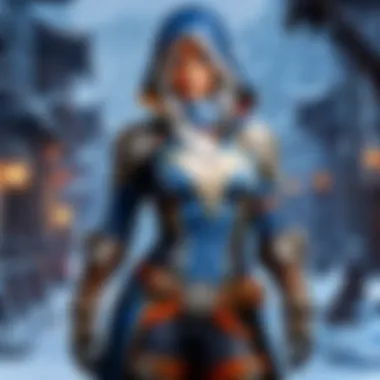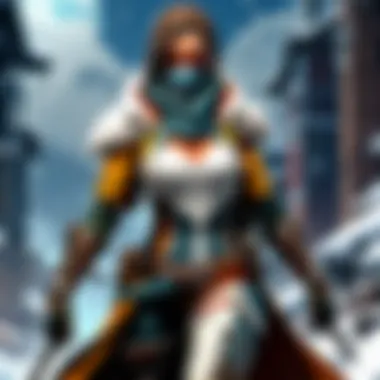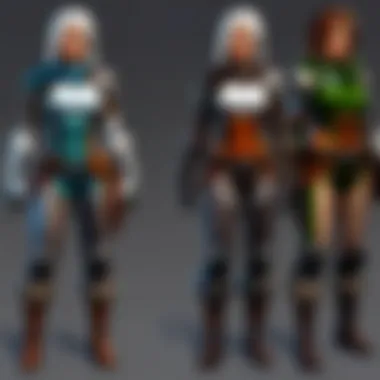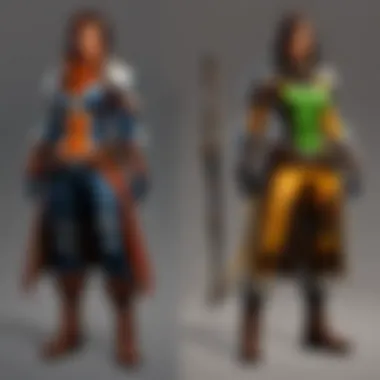The Significance of Rogue Attire in Blizzard Games


Intro
Rogue attire serves as a critical element in Blizzard's gaming universe, providing players not only with functional gear but also with a representation of their characters' identities. The designs and aesthetics of rogue outfits are deeply intertwined with gameplay mechanics and historical contexts within the lore. Players often see these garments as extensions of their character's persona, blending style with the strategic aspects of gameplay. As we dissect the various dimensions of rogue attire, we will highlight its influence on gameplay strategies, design choices, and character identity across different Blizzard franchises.
Game Updates and Patch Notes
In recent years, Blizzard has made several updates to its popular games that affect rogue classes. Staying informed about these updates is crucial for players invested in maximizing their performance.
An overview of recent game updates reveals a consistent effort to balance gameplay while enhancing the rogue experience. For instance, patches often tweak the abilities of rogues, introducing new skills or refining existing ones.
Detailed Breakdown of Patch Notes
Players can find detailed patch notes on Blizzard's official website. Key changes in recent updates include:
- Adjustments to damage output for certain rogue abilities.
- Introduction of new equipment sets that enhance stealth mechanics.
- Revisions to crowd control abilities, making them more effective in gameplay scenarios.
These adjustments are pivotal as they may substantially affect a player's strategy and character build.
Analysis of Impact on Gameplay and Community Feedback
The feedback from the gaming community often reflects a mixed response to these changes. While some players appreciate the balancing efforts, others express concerns about how recent updates affect their preferred playstyles. Ongoing community discussions on platforms like Reddit demonstrate the passionate engagement of players when it comes to evolving rogue mechanics.
Character Guides and Strategies
Effective mastery of a rogue character demands a deep understanding of their abilities and strategies.
In-depth guides provide insights into various rogue classes across Blizzard games, from World of Warcraft to Hearthstone.
Tips for specific characters include:
- Utilize stealth effectively to initiate attacks.
- Choose talents that align with preferred playstyle, whether aggressive or defensive.
- Develop a tactical approach toward equipment choice based on current patch adjustments.
By mastering these essentials, players can elevate their gameplay experience.
Community News and Events
Blizzard's community remains vibrant and active. Events and tournaments related to rogue play are frequent, often showcasing top-tier players utilizing diverse strategies and styles of play. Additionally, fan-made content celebrates rogue classes, from art designs to creative builds shared across platforms like Facebook.
Updates on upcoming events are essential for players wanting to engage or participate actively in the community.
Fan Theories and Lore Discussions
The lore behind rogue classes in Blizzard games is vast and layered. Players frequently engage in discussions about the significance of rogue attire within the narrative context of the games.
Speculating on future narratives and secret insights can deepen understanding and appreciation for the rogue identity. For example, fan theories might explore how certain historical figures in lore influenced design choices for rogue garments.
"Rogue attire is not just a costume; it symbolizes a character's fight against tyranny and their choice of morally ambiguous actions that challenge norms."
Ending
Rogue attire within Blizzard universes transcends mere function; it encapsulates character identity, narrative depth, and the strategic elements of gameplay. As the gaming landscape continues to evolve, the significance of these aspects only grows. Understanding the intricacies of rogue attire enhances both the lore appreciation and the practical strategies required in gameplay.
Understanding Rogue Attire
Rogue attire plays a critical role in shaping a character's identity within the various universes created by Blizzard. This section discusses its significance in gameplay and design. Rogues are often characterized by their stealth, agility, and cunning, and their clothing reflects these traits. Understanding rogue attire helps players appreciate not only the aesthetic choices but also how these choices enhance gameplay experience.
In this article, we will examine how rogue attire influences gameplay, contributes to historical contexts, and enhances player immersion. The design of rogue clothing encompasses various elements that serve functional purposes while keeping up with the artistic vision of the games. This balance between style and utility is particularly noteworthy, as it impacts how players perceive and embrace their characters.
Definition and Role in Gameplay
Rogue attire signifies more than just a decorative aspect; it embodies the essence of the character’s gameplay role. Typically, these garments are designed to allow for silent movement, conceal weapons, and aid in tactical positioning. In terms of functionality, rogues rely on their clothing to provide agility and stealth to execute strategies in combat effectively.
The common traits of rogue attire include:


- Lightweight Materials: To ensure mobility and agility.
- Hoods and Masks: These items often conceal identity, providing an element of mystery.
- Utility Features: Pockets and slots for carrying daggers or other equipment are common.
Understanding how these elements work together can greatly enhance the player's approach in various gaming scenarios. A rogue's success often hinges on the ability to outmaneuver and surprise opponents, making their attire a crucial component.
Historical Context of Rogues in Gaming
The archetype of the rogue in gaming has evolved significantly since the introduction of early video games. Traditionally, rogues were often depicted as thieves or assassins, wearing practical clothing suitable for stealthy missions. In early role-playing games, such as Dungeons & Dragons, the rogue class was defined by its ability to avoid detection and pick locks, leading to a distinctive style that would influence later representations in gaming.
Blizzard's approach to rogue attire has drawn inspiration from these roots while integrating modern design elements. Each title brings new interpretations of the rogue stereotype, adapting the clothing style to fit within the narrative of the game and its world-building. For instance, while World of Warcraft offers a rich tapestry of rogue designs, emphasizing class specializations and lore, the Diablo series presents a grittier aesthetic that reflects its darker themes.
This historical trajectory is crucial for understanding how rogue attire has influenced gaming. It shows a shift from simple, functional designs to more intricate outfits that blend storytelling with gameplay mechanics. Overall, a deep dive into the historical context helps players to appreciate not only the visual aspects but also their narrative significance in the broader gaming ecosystem.
The Evolution of Rogue Attire in Blizzard Games
The evolution of rogue attire in Blizzard games is not just about aesthetics; it signifies changes in gameplay philosophy, narrative integration, and cultural reflections within each gaming franchise. Initially, designs were simple and often utilitarian, focusing more on function than style. However, as the games progressed, there came a deeper understanding of how a character's appearance can influence player immersion and identity. By exploring the evolution of rogue attire, one can gain insight into the changing perceptions of rogues themselves, from generic stealth characters to multi-faceted individuals with rich backstories and unique designs.
Classic Games: The Beginnings of Rogue Fashion
In the early days of Blizzard's gaming titles, specifically in games like "Warcraft" and the original "Diablo," rogue attire was rather basic. The emphasis was placed squarely on gameplay mechanics. Rogues were depicted with darker shades to underscore their stealthy nature. Materials used were limited, often comprising simple leather and cloth textures, which were practical for the types of environments and interactions these characters would encounter.
The simple wardrobe choices reflected the limited technology and design choices of the time. The functionality was paramount, with little regard for flair. Designs adhered to a formula, reflecting an archetype that easily communicated the rogue's role in gameplay without the need for elaborate features. As players developed a preference for customization, the need for more complex designs emerged, but the early iterations laid a strong foundation for rogues as agile and elusive characters.
Modern Updates: Changes in Design and Functionality
With titles like "World of Warcraft" and the various expansions that followed, rogue attire underwent significant transformations. Blizzard recognized the importance of visual diversity and player expression, which led to more varied and intricate designs. Rogues now sport elaborate armor sets, with distinct styles that convey personal stories and class specializations.
The modern design approach incorporates multiple materials and textures. Soft leather blends with metallic details, introducing a sense of realism and sophistication often missing in earlier models. Color schemes play a more critical role too. Shades of green, purple, and black not only aid in stealth but also represent the rogue's connection to the universe's lore.
Gameplay functionality also evolved. Attire now offers bonuses to speed and stealth, directly influencing how a player engages with the game world. Specializations allow for further customization, meaning players can choose attire that enhances their playstyle, whether they prefer melee combat or ranged tactics. This evolution is a reflection of both technological advancements in gaming and a sharper focus on holistic character interactions within immersive settings.
"With each new title and expansion, Blizzard solidifies the rogue's identity through clothing that tells a story beyond gameplay and integrates seamlessly into the lore."
Through understanding the evolution of rogue attire, we can appreciate how Blizzard games have shaped the perception of rogues in gaming, turning them from simple character archetypes into rich representations of narrative and gameplay interactivity.
Key Elements of Rogue Clothing
Rogue attire plays a pivotal role in defining the aesthetics and functionality of gameplay across Blizzard's universes. Each element of clothing not only serves an artistic purpose but also enhances the character's abilities, reflecting the character's identity while considering gameplay mechanics. Understanding these key elements helps players appreciate the depth of design behind rogue characters, making their journeys through the games more immersive and nuanced.
Materials and Textures Found in Rogue Attire
The materials used in rogue clothing add a layer of realism and practicality to their appearance. Common materials include leather, chainmail, and cloth. Each has its own advantages. For instance, leather offers flexibility and lightness, allowing for stealthier movement. It is a popular choice in World of Warcraft for rogues who prioritize agility in combat.
Chainmail, while heavier, provides better protection against physical attacks. Some designs integrate both materials, blending protection with mobility. Cloth is often used for the inner lining or accessories, offering comfort and facilitating free movement. These choices in materials together contribute to the character's overall performance, defining how they interact within the game.
Color Schemes and Their Symbolism
Color plays a crucial role in rogue attire, often embodying traits such as stealth, cunning, and agility. Dark colors like black, gray, and deep green are predominant among rogue outfits. These hues serve to cloak the wearer in shadows, enhancing their ability to blend into environments. The choice of color also reflects the lore associated with the character. For example, a rogue affiliated with sinister factions will typically wear darker, more muted colors, symbolizing their hidden motives.
Bright colors, though less common for rogues, can signify different aspects. For instance, a rogue working for a noble cause might don lighter shades to present a more approachable image. Thus, color not only impacts gameplay but also reinforces the narrative surrounding the character's identity.
Functionality: Stealth Mechanics and Mobility
Functionality is perhaps the most vital element of rogue attire. Stealth mechanics are at the core of what defines a rogue's gameplay style. The clothing must facilitate quiet movement, ensuring that footsteps are muffled and the overall silhouette is minimized. Many designs incorporate elements like hoods and masks, ensuring that the character's identity can be obscured while remaining focused on their tasks.
Mobility is also crucial. Rogue clothing is tailored to allow for maximum agility, accommodating swift movements during combat or escape situations. Features such as adjustable straps, lightweight layers, and ergonomic designs ensure that rogues can traverse different terrains without cumbersome materials restricting action. In essence, the clothing enhances not only visual appeal but also the character’s functional abilities in gameplay.
"The intricate design of rogue attire is a blend of artistry and functionality, where each element serves a purpose in both aesthetics and gameplay."


Through an in-depth understanding of these elements, players can gain insights into the thought process behind rogue character designs, enriching their gaming experience in the vast landscapes offered by Blizzard.
Rogue Classes Across Blizzard Titles
Rogue classes are a significant component within Blizzard's games, showcasing unique attire that aligns with each game's mechanics and aesthetic. Understanding the rogue archetype across different titles helps fans appreciate the design's practical yet visual appeal. This section dives into the diverse interpretations of rogue classes in franchises like World of Warcraft, Diablo, and Overwatch.
Rogue in World of Warcraft
Class Specializations and Attire Variants
In World of Warcraft, the rogue class features multiple specializations, each with distinctive attire variants tailored to their specific roles. Assassination rogues typically wear lightweight, dark clothing, emphasizing stealth. Their attire prioritizes mobility, allowing them to move unnoticed across the battlefield. Meanwhile, subtlety rogues often have a more theatrical appearance, incorporating elements like capes and masks. This versatile range caters to both playstyle and personal preference.
Notably, the attire variants reflect the game's lore and player choice. Each specialization looks distinct and enhances gameplay, enabling players to engage with their characters more effectively. Players often enjoy customizing these options for aesthetic pleasure while adhering to the core mechanics of their chosen specialization.
Influence of Lore on Design
The lore surrounding rogues in World of Warcraft has a strong influence on their design. From the shadows of the Undercity to the nighttime escapades in Darnassus, the attire worn by rogues showcases their backgrounds and allegiances. Renowned for their cunning and agility, the design often incorporates features that symbolize their hidden nature, such as hoods and dark colors.
This connection between lore and attire contributes to the immersive quality of the game. Players know that their clothing signifies tribal history, which enhances the connection they feel to the world. Each outfit tells a story, tying players' in-game experiences to the rich narratives that Blizzard provides.
Rogue in Diablo Series
Characterization through Attire
In the Diablo series, the rogue character's attire plays a vital role in emphasizing their identity. The original rogue from Diablo II has a blend of functionality and being visually appealing, highlighting their agility and deadly prowess. Their designs often reflect the grim tones characteristic of the series, utilizing dark leather and rugged materials.
This characterization through attire allows players to immerse themselves in a setting filled with danger. The attire resonates with the overall theme of the game, and it is popular because it effectively communicates the character's lethal skills and role without extensive backstory.
Mechanics of Design and Use
The mechanics of design and use in the Diablo series are practical for gameplay. The attire worn by rogues offers protection while also allowing for a necessary degree of freedom of movement. The garments are purposeful, giving players the confidence to engage in the fast-paced combat Diablo is known for.
Another advantage is how the designs accommodate various player styles. From choosing between light armor for speed or heavier pieces for defense, they appeal to a wide variety of gamers seeking specific play styles.
Rogue in Overwatch
Modern Aesthetic and Gameplay Role
In Overwatch, the rogue class is represented by characters like Genji and Sombra, each showcasing modern aesthetics that blend technology with traditional rogue elements. Genji's attire combines sleek armor and ninja influences, enhancing his agile gameplay. Sombra's design leans towards a cyberpunk aesthetic, with clothing that mirrors her identity as a hacker.
This modern take enriches how players perceive rogues and allows for innovative gameplay mechanics, making them vital in team dynamics. Their attire contributes to unique gameplay styles that extend beyond the traditional rogue archetype while still paying homage to its roots.
Impact of Character Design on Community
The impact of character design on the community is notable in Overwatch. Fans often express their admiration for the intricate details placed in character attire, leading to a vibrant culture of fan art and discussions. Sombra's design, for example, has sparked numerous community discussions about character identity and symbolism.
Moreover, this engagement fosters a closer connection between players and their heroes. The attention placed on attire resonates with players, encouraging them to explore gameplay further and fostering a sense of bonding and shared identity within the community.
Overall, the exploration of rogue classes across Blizzard titles highlights the significance of attire in each game's narrative and gameplay mechanics.
Influences on Rogue Design
Rogue attire in Blizzard games is not merely a collection of fashionable elements. It is a reflective synthesis of cultural contexts, artistic vision, and gameplay mechanics. The design choices for rogue clothing are informed by various factors, which contribute not only to the aesthetic appeal but also enhance gameplay experience. Understanding these influences is crucial to appreciate how they shape the rogue identity in gaming.
The significance of cultural inspirations lies in how they ground the rogues within a broader narrative framework. Much of the attire draws from historical and fictional themes, allowing players to connect on a deeper level. The interplay between lore and design creates an immersive experience that resonates with players' expectations and imaginations.


Artist contributions further enrich the visual language of rogue classes. Artists infuse their unique perspectives and styles, which play into the overall experience of the game. The combination of these influences results in attire that is not only functional but also rich with character and style.
Cultural Inspirations Behind Rogue Attire
Cultural inspirations are foundational to the design of rogue attire. Much of the rogue visual language is inspired by a mix of historical warriors, thieves, and mythological figures. From the shadowy figures of medieval Europe to the mystical assassins of the East, various elements coalesce to form a unique aesthetic. Players can see this fusion in various accessories, like hoods and cloaks, that embody stealth and agility.
These cultural touchpoints help ground rogues in a reality that feels familiar, even in fantastical settings. The use of certain colors and materials often hints at specific cultural backgrounds. For example, darker colors are prevalent, representing stealth and secrecy, while textures like leather connote durability and movement.
"Rogue attire often serves as a visual storytelling mechanism, merging practicality with layers of meaning."
By drawing on these diverse influences, the design of rogue characters appeals to players from different backgrounds, enhancing their engagement.
Artist Contributions to Rogue Aesthetic
The role of artists in shaping the rogue aesthetic is vital. Artists create a visual narrative that complements the gameplay experience. Their interpretation of rogues often leads to innovative designs that push the boundaries of original concepts. The artistry reflects not only the lore but also the gameplay mechanics, ensuring that attire symbolizes the rogue's function in the game.
For instance, the intricate details in armor or the fluid lines in a cloak design convey movement, indicating agility. Moreover, the aesthetics are tailored to fit within the game's environment. Designers employ color palettes that are harmonious with the game's world while ensuring that rogues stand out in their distinctive roles.
Artists’ contributions also extend to community-driven content, influencing how rogues are perceived and celebrated within the gaming community. Players often engage with the designs by creating fan art or cosplay, further enriching the overall rogue narrative.
In summary, the influences on rogue attire in Blizzard universes come from a blend of cultural elements and artistic vision. These factors enhance not just the look of a rogue but solidify their identity within the game's universe, ultimately shaping player experiences.
Community Perspectives on Rogue Attire
The community surrounding Blizzard games is vibrant and interactive. Players often express their thoughts and creativity regarding rogue attire, which plays a significant role in the overall gaming experience. Understanding community perspectives goes beyond simple preference. It sheds light on how players engage with the game, how they perceive their identities, and gives a voice to those who are passionate about design.
Rogue attire serves as a visual representation of a player's personal engagement. Each piece of clothing or armor tells a story about choices made within the game. Fans discuss these elements on various platforms such as Reddit, Discord, and dedicated fan sites. This interaction helps shape the evolution of rogue attire, creating a bridge between the creators and the players.
Fan Art and Community Creations
Fan art is a prime example of how the community influences rogue design. Artists in the Blizzard community often reimagine rogue classes, providing fresh interpretations of classic designs. This creative output not only showcases their skills but also indicates what aspects of rogue attire resonate most with players.
- Community creations can be seen in many forms:
- Original characters that blend elements from different Blizzard games.
- Modified existing rogues to fit unique personal styles or themes.
- Collaborations among artists to create intricate pieces that celebrate rogue classes.
The significance of fan art extends to how it feeds back into Blizzard’s design decisions. The company pays attention to trends and feedback from their community. Sometimes, elements from popular fan art can influence future official designs, fostering a continuous dialogue between the developers and players.
Discussion on Fashion and Functionality
The balance between fashion and functionality is a contentious topic within the community. Rogue attire, while visually appealing, must also serve practical gameplay purposes. Players often debate which attire performs best in certain scenarios, such as raids or PvP battles. Some prefer the aesthetics of an outfit, while others prioritize its in-game effectiveness.
Key considerations include:
- Stealth Mechanics: Attire may feature designs that enhance stealth capabilities, which are crucial for rogues. Players analyze how different designs impact gameplay.
- Mobility and Agility: Clothing must allow for quick movement. Discussions include fabric choices and how they mirror gameplay mechanics.
- Lore Representation: Many fans feel that attire must reflect the lore of the character. They argue that the story behind an outfit can enhance immersion, leading to a deeper connection with the character.
Final Thoughts on Rogue Attire
Rogue attire in the Blizzard universe serves a multifaceted purpose that extends beyond mere aesthetics. It encapsulates both the identity of the rogue class and the deeper narrative elements of each game. The clothing choices reflect not only the gameplay mechanics but also the lore and cultural inspirations that influence character design. Understanding this relationship enhances the appreciation for the thought and creativity that goes into each unique piece of rogue attire.
The Future of Rogue Design in Gaming
As we look toward the future, the design of rogue attire is likely to evolve further as gaming technology advances. Innovations such as virtual reality and augmented reality may change how clothing is perceived within the gaming space. Players could expect attire that reacts more dynamically to in-game actions or environments.
Moreover, there is a growing trend toward personalization and customization in gaming. Players want to make their characters truly their own. As a result, rogue attire may become more about individual expression rather than strict adherence to class norms. This shift promises to make rogue attire a more integral part of a player's gaming experience.
"The attire of a rogue is a silent storyteller, weaving narratives of stealth and cunning through fabric and design."
Ending: The Impact of Attire on Rogue Identity
An analysis of rogue attire reveals its significant impact on character identity within the Blizzard gaming universe. The clothing reflects not only a rogue's profession but also personal traits and the overarching narrative of the game. Each piece of attire provides cues about the character's role, abilities, and even their background story.
This profound connection means that players often feel a greater attachment to their rogue characters. When players invest time into exploring every facet of their attire, it enhances their experience. They do not simply play the game; they embody the character.



